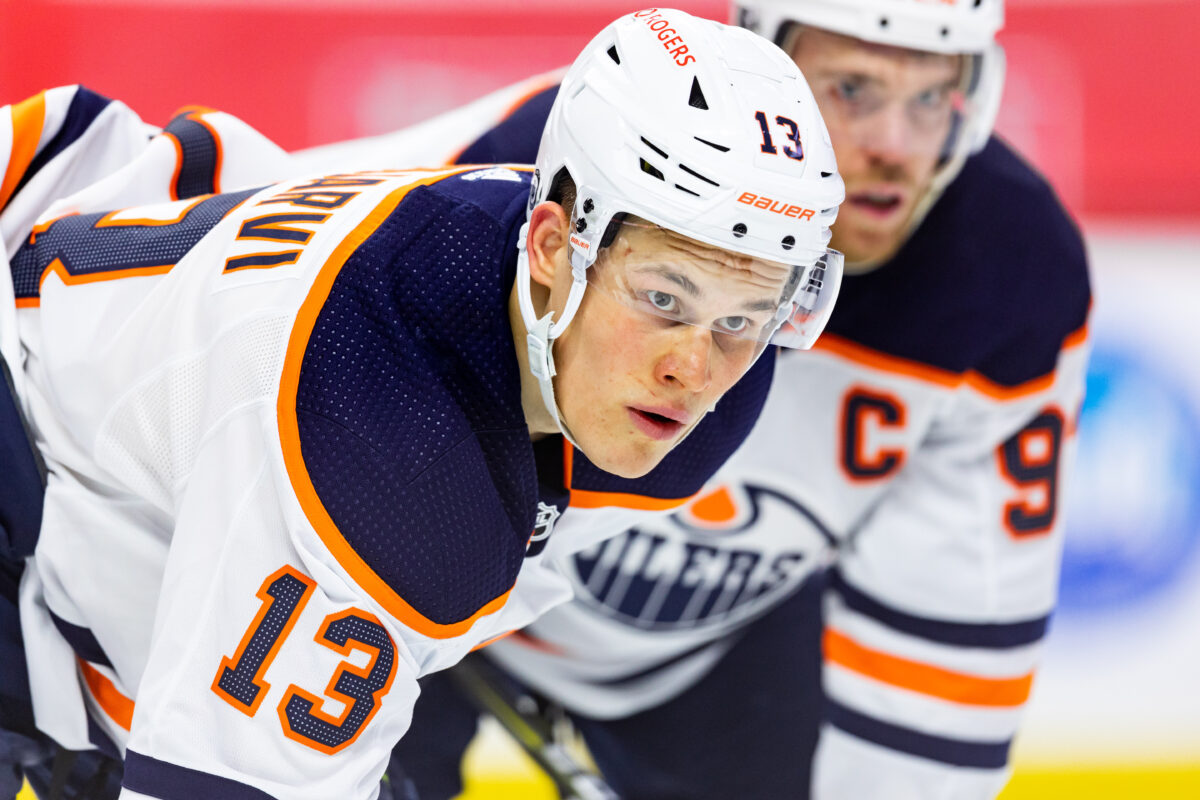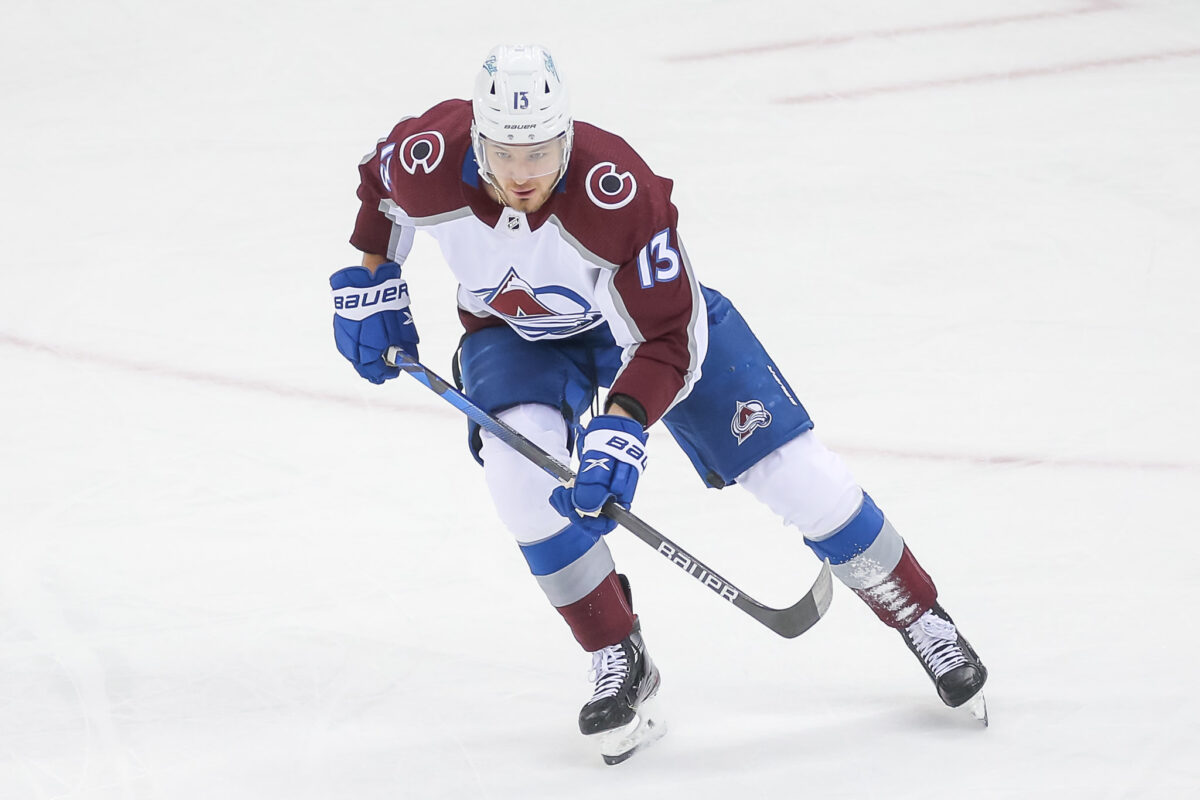It appears as though Jesse Puljujarvi‘s time with the Edmonton Oilers has run out (again). Sportsnet’s Mark Spector reports that the Oilers are taking trade calls on the disgruntled forward, with an eye on maximizing the potential return. After the the Colorado Avalanche enjoyed a superb 2021-22 season in winning their third-ever Stanley Cup, a number of key contributors are set to hit the open market, potentially leaving the team with several holes in the lineup. Due to his underrated defensive impacts and relatively low acquisition cost, the Avalanche should make the Finnish winger a primary trade target this offseason – let’s dig in.
Puljujarvi Could Be the Avalanche’s Next Nichushkin
You might be asking, why would the Avalanche have any use for a player who hasn’t lived up to their heady draft pedigree? After all, when was the last time a tall, rangy forward with strong defensive impacts who experienced a tortured offensive season became available in a trade or in free agency? As has become readily apparent in the years leading up to their eventual Stanley Cup triumph, the Avalanche lean heavily into analytics to make astute roster decisions, identifying useful players who might be underrated due to damaged reputations or low scoring totals.

As I alluded to earlier, playoff hero Valeri Nichushkin was snagged for under $1 million after being cast away by the Dallas Stars following several wretched years with the organization. Between underperforming his draft stock and a brief sojourn to Russia, his tenure was punctuated by a miserable 2018-19 season in which he tallied zero goals in 57 games. For all intents and purposes, the Russian winger was another example in a long line of players who possessed tremendous physical gifts but could not leverage them in any meaningful way at the NHL level.
Still, the Avalanche rightly identified that he was misused in his role with the Stars, had significant impacts beyond the boxscore, and put him in a position to succeed. As a result, he followed up his breakout regular season (52 points in 62 games) with an even more impressive playoff campaign (15 in 20), making several significant plays in Colorado’s Stanley Cup run. The parallels between the two forwards are uncanny. Puljujarvi hasn’t produced the scoring totals expected of a fourth-overall pick, counting 15 goals (2020-21) and 36 points (2021-22) as his single-season career-highs. Like Nichushkin, he returned to Europe to rediscover his game before being lured back to the NHL. Most importantly, he boasts robust defensive impacts that don’t necessarily show up on the scoresheet, driving down both his salary and acquisition cost.
Much of the dissatisfaction surrounding Puljujarvi is that despite receiving ample playing time beside the Oilers’ superstars in Connor McDavid and Leon Draisaitl, his scoring totals leave a lot to be desired. After converting on over 11% of his 5v5 shots in 2020-21, his scoring rate dropped to 6.9% this past season, his lowest mark since his rookie season. That’s in spite of the fact he generated career-highs in shot attempts (iCF/60) and scoring chances (iSCF/60) at 5v5, suggesting he could experience a reversal in form next season if he gets back to his career finishing pace. Given that the Oilers have severely misjudged shooting patterns in the past, Puljujarvi could become another tally on that list.
Although he’s a capable middle-six talent, Puljujarvi’s primary appeal is his track record as a formidable two-way force, something that rarely manifests itself in the boxscore. According to Corey Sznajder’s tracking data, he applied the third-highest rate of forechecking pressures among Oilers’ forwards last season, showing a willingness to harass opposing defenders deep in the offensive zone. He also demonstrated a deft ability to retrieve the puck from the corners in his own zone and turned those retrievals into zone exits at an above-average rate.
Most crucially, Puljujarvi is a strong play-driving winger, posting stellar possession results with or without the Oilers’ two superstars up front. Since returning from Finland ahead of the 2020-21 season, he’s played 306 minutes at 5v5 without either of McDavid or Draisaitl. In those minutes, the Oilers still controlled 55.3% of expected goals (xGF%), 51% of scoring chances (SCF%), and 58.6% of high-danger opportunities. Sure, he’s struggled to finish his chances, (MoneyPuck had him at minus-6.9 goals below expected in 2021-22 – the 13th-worst tally in the league) but that doesn’t mean he has nothing to offer. If teams can temper their expectations, they could have a gem on their hands.
Puljujarvi Trade Comes With Low Acquisition Cost
According to Spector, scouts from around the league believe Puljujarvi could be had for a second- or third-round pick. Although he does not name the Avalanche as one of the frontrunners, nor do they own a second-round pick until 2025, that should not eliminate them from trade discussions. The team still holds its own third-rounders in 2022 and 2023, as well as a fourth-round pick in 2024. Could a package including one or more of those three picks or tacking on one of the Avalanche’s prospects entice the Oilers to part ways with the 24-year-old forward?
You may also like:
- Colorado Avalanche Won’t Be Contenders This Season
- Colorado Avalanche Lineup Projection for 2024-25
- Avalanche Giving Nikolai Kovalenko a Chance to Prove Himself
- 3 Avalanche Players With the Most to Prove in 2024-25
- Peter “Foppa” Forsberg: A Biography
In terms of cap space, the Avalanche have over $25 million available heading into the 2022 offseason, although much of that will be swallowed up by new contracts to one or more of Nichushkin, Andre Burakovsky, Nazem Kadri, and Artturi Lehkonen. Given that three of the four are unrestricted free agents (UFAs), Puljujarvi could prove to be a more cost-effective option than those likely to command a hefty salary on the open market.
Two projections I found pegged his next contract at carrying an average annual value (AAV) of just under $2 million (Dobber Hockey; no specific term offered) or between $3- and $4 million on a bridge deal of two or three years (from the Evolving Hockey team). For a young, restricted free agent (RFA) with plenty of upside, that is a manageable cap hit that could turn into an incredible value deal a la Nichushkin, albeit on a much smaller scale.

One thing that should give any acquiring team pause is that Spector mentions that a big reason for Puljujarvi’s impending departure is that his teammates allegedly found it difficult to play with him on their line. As the Avalanche boast no shortage of talent at both ends of the ice, could this become a point of contention with their own stars? The issues around his fit in the lineup might be blown out of proportion, but it’s worth noting nonetheless.
Puljujarvi is a Perfect Buy-Low Trade Option
Given that the Avalanche enjoyed an exhilarating Stanley Cup run, members of its supporting cast are unsurprisingly in line for large raises on their new contracts. It’s likely that one or more leave for greener pastures, meaning the onus is on management to replace their on-ice impact this offseason. Trading for Puljujarvi is the type of high-profile but low-risk swing the team should be making to extend its Stanley Cup window, and they can provide him with the organizational support and infrastructure that has often been lacking in Edmonton. If he finds his way to the Avalanche, don’t be surprised if the hockey world is singing his praises at this time next year. After all, who doesn’t love a good redemption story?
Data courtesy of AllThreeZones, Evolving Hockey, MoneyPuck, and Natural Stat Trick.
